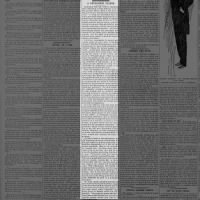A DEVELOPING FACTOR.
Assuming that the; bicycle is a permanent institution it is not difficult to foresee the peculiar effect which it will have on the growth and development of San Francisco. It being an established fact that cheap and swift urban transportation is an exceedingly important factor in determining the character and extent of a city's spread, and the bicycle having proved its ability to compete with all kinds of street railways and livery service, two considerations now present themselves. One is that the districts having the smoothest pavements will be those which develop most rapidly, and the other is settlement will proceed most easily in level and approximately level areas.The factor represented by smooth pavements exists in every city. It happens, however, that San Francisco has a peculiar topography, its steep hills presenting an obstacle which the bicycle cannot overcome. At the same time it has very large approximately level areas, which include nearly the whole of the settled region south of O'Farrell street. That is to say, about two-thirds of the City as it is at present settled can fall under the developing influence of the bicycle. It is very greatly to the interest of every section which has no prohibitory grades to offer smooth pavements to bicyclists.
With the exception of a few streets running north and south, such as Van Ness avenue and parts of Devisadero [sic] and Stanyan streets, the Western Addition has too steep grades for the bicycle, and even these streets do not give safe and pleasant access to anything like the whole of that region. Hence the bicycle cannot be an important factor in the development of the northern end of the peninsula. For that matter, as the wealthier residents are concentrating in that section, and so, however much they may indulge in cycling as a pastime or hygienic measure, they will never employ it as a business convenience, it is easy to see that the streetcar lines traversing that section will receive no serious injury from bicycle competition.
It is very different with the more level parts of the City, and it is here that serious economic problems are to be solved. Street railways here will suffer, and development will bear a rigid relation to the condition of the streets. A wheelman demands a bituminous pavement, and a wheelman who works for a salary will pitch his home, whether as a boarder, a renter or a freeholder, on a street which has the easiest grade and the smoothest pavement. The pavement which Folsom street is preparing to lay will send thousands of homeseeking wheelmen to that thoroughfare, and this extraordinary demand alone will raise rentals and increase the value of property.
All this is based on the assumption that the bicycle as a business convenience will not only retain its present-popularity, but that this employment of it will be very largely increased. This is not altogether an assured fact. Say that a man pays 10 cents a day for car fare, and that he has sixty-five holidays (including Sundays) in a year. This would make his necessary personal streetcar expense $30 a year. He will spend at least $10 a year more for himself and family, making $40. A bicycle costing $100 will last, say four years, and the expense for repairs will be, say $10 a year. This is $35 a year. His family will spend car fare in addition, so that apparently there is not much economy in a bicycle. But it has one tremendous advantage —the pleasure, freedom and health that it gives in the riding, and these alone seem sufficient to give it a permanent monopoly.
We shall expect therefore that the level parts of San Francisco will develop rapidly under the influence of the bicycle, and that it will even serve to bring into proper notice that whole sadly neglected region lying south of Market street and east of Seventh. The property-owners who fail to take these considerations into account and provide smooth streets may live to rue their negligence.

Comments
Post a Comment